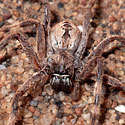|
Genus: Parapalystes
Life
> Eukaryotes
>
Opisthokonta >
Metazoa
(animals) > Bilateria > Ecdysozoa > Panarthropoda > Tritocerebra >
Arthropoda > Arachnomorpha > Cheliceriformes > Chelicerata > Euchelicerata
> Arachnida > Araneae
> Araneomorpha > Family: Sparassidae (huntsman
spiders)
Five species, endemic to southern Africa.
Species native to southern Africa
|
Parapalystes cultrifer
(Pocock, 1900)
South Africa |
|
|
Parapalystes euphorbiae
Croeser, 1996
South Africa |
 |
|
Parapalystes lycosinus
(Pocock, 1900)
South Africa |
|
|
Parapalystes megacephalus
(C. L. Koch, 1845)
South Africa |
|
|
Parapalystes whiteae
(Pocock, 1902)
South Africa |
|
Description
To the lay person Parapalystes can be separated
from Palystes on colour and markings. It tends towards grey, has a
yellowish clypeal moustache and dark folium marking on dorsal abdomen.
Distribution
Endemic to southern Africa, occurring in the Eastern, Northern
and Western Cape, as well as Namibia (Oranjemund).
Behaviour
Spiders reported by Croeser in Namaqualand and Larsen at
Oranjemund and on the Cape Peninsula retreat into an inverted cup shaped
nest. This retreat is produced by pulling desert plants or restios together.
Where they meet the silken retreat is constructed. It was noted that a
species photographed at St Helena (Western Cape), made a simple nest in a
hole in a brick wall.
Derivation of name
Parapalystes is
derived from the Greek para meaning near or close to
the Latin palaestes or
Greek palaistes, meaning wrestler.
Text by Norman Larsen © |
